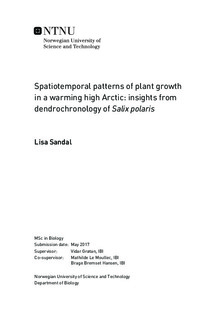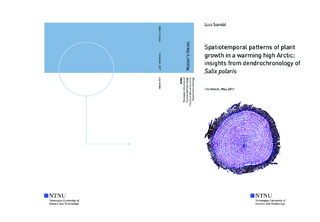| dc.contributor.advisor | Grøtan, Vidar | |
| dc.contributor.advisor | Le Moullec, Mathilde | |
| dc.contributor.advisor | Bremset Hansen, Brage | |
| dc.contributor.author | Sandal, Lisa | |
| dc.date.accessioned | 2017-06-09T14:00:43Z | |
| dc.date.available | 2017-06-09T14:00:43Z | |
| dc.date.created | 2017-05-15 | |
| dc.date.issued | 2017 | |
| dc.identifier | ntnudaim:14340 | |
| dc.identifier.uri | http://hdl.handle.net/11250/2445603 | |
| dc.description.abstract | Climate change is most pronounced at high latitudes, where plant and animal populations are often strongly regulated by environmental drivers. Theory suggests that if these environmental drivers are synchronized over large distances, this spatial synchrony should also be reflected in the population synchrony of wildlife.
Here, I used dendrochronological tools to analyse for climate drivers and their role in the synchronization of fluctuations in Salix polaris ring-width growth across large distances in high-Arctic Svalbard.
I found that while summer temperature had an overall strong positive effect on S. polaris tree-ring growth across Svalbard, growth responded strongly negatively to rain-on-snow events at some wet coastal sites. Shrub growth across Svalbard was correlated over large distances, and summer temperature contributed significantly to the observed synchrony. There was a marked decline in the spatial synchrony in plant growth since the late 1990s, which was partly explained by the reduced spatial synchrony in summer temperatures occurring in parallel with the overall warming trend. These findings have fundamental implications for understanding ecosystems in space and time. | |
| dc.language | eng | |
| dc.publisher | NTNU | |
| dc.subject | Biology (MSBIO), Ecology, Behaviour, Evolution and Biosystematics | |
| dc.title | Spatiotemporal patterns of plant growth in a warming high Arctic: insights from dendrochronology of Salix polaris | |
| dc.type | Master thesis | |

